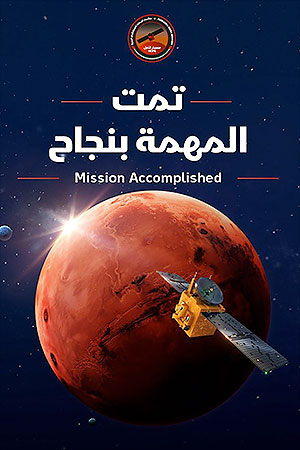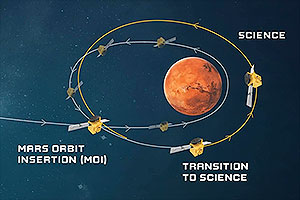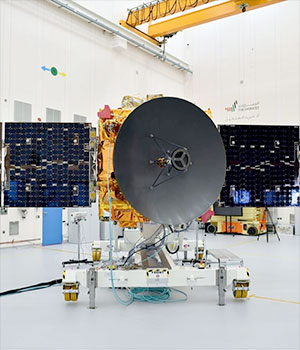February 9, 2021 — The United Arab Emirates (UAE) successfully put a probe into orbit around Mars, becoming only the fifth entity in history to accomplish the interplanetary feat.
The UAE's "Hope" ("Al-Amal" in Arabic) spacecraft arrived at the Red Planet on Tuesday (Feb. 9), after a seven-month, 307-million-mile (494-million-kilometer) journey. The $200 million Emirates Mars Mission is the UAE's first space project to reach beyond Earth orbit and is the first Arab-led mission to another planet.
"Success! Contact with Hope has been established again. The Mars orbit insertion is now complete," the mission team announced on Twitter.
The news came after the completion of an autonomously-executed 27-minute, six-thruster burn to slow the spacecraft's approach to Mars from 75,000 miles per hour (121,000 km/h) to about 11,000 mph (18,000 km/h), such that Hope could be captured by the planet's gravity.
Mission managers at the Mohammed bin Rashid Space Center in Dubai broke into applause after the probe's signal from Mars reached Earth. The UAE celebrated the achievement by lighting up buildings in red, including the tallest structure in the world, the Burj Khalifa.
The complete picture
The Hope probe was designed to provide the first "complete picture" of Mars' atmosphere and its layers in an attempt to answer key questions about the loss of hydrogen and oxygen into space over the span of one Martian year.
Before beginning to collect data, the small, solar-powered spacecraft will spend about six weeks in its initial elliptical "capture" orbit, circling Mars between 600 miles and 30,700 miles (1,000 and 49,380 km) above the planet. During this time, mission managers will check out the probe's systems and take the mission's first image of Mars.
The probe will then transition into its science orbit, rounding Mars once every 55 hours while following an elliptical path between 12,000 and 27,000 miles (20,000 and 43,000 km) above the surface.
Limited to communicating with the UAE's Mission Operation Center six to eight hours twice a week, the Hope probe will spend two years using its infrared and ultraviolet spectrometers, as well as a multi-wavelength camera, to complete the first planet-wide, 24x7 assessment of Mars' atmospheric dynamics and weather.
Launched on July 19, 2020 from the Tanegashima Space Center in Japan, the Hope probe was built at the Laboratory for Atmospheric and Space Physics at the University of Colorado, Boulder. The UAE also worked with scientists at Arizona State University, Northern Arizona University and University of California, Berkeley to design the Emirates Mars Mission.
The Mars Club
The UAE's Hope probe has now joined NASA, European Space Agency (ESA) and Indian Space Research Organization (ISRO) missions in active use around and on Mars.
In addition to past missions by Russia, the UAE is only the fifth nation to study Mars from up-close and only the second to achieve success on its first attempt after India.
"Congratulations Hope on your safe arrival to Mars' orbit! Your bold endeavor to explore the Red Planet will inspire many others to reach for the stars," Thomas Zurbuchen, NASA's associate administrator for science, wrote on Twitter. "We hope to join you at Mars soon with Perseverance."
Hope's arrival marked the first of three incoming Mars missions. China will attempt its first Mars orbit insertion on Wednesday (Feb. 10) with its Tianwen-1 spacecraft, followed by its first try at landing a rover on the planet in May.
NASA, meanwhile, will attempt to land its fifth Mars rover, Perseverance, in Jezero Crater on Feb. 18.
The Emirates Mars Mission, which coincides with the 50th anniversary of the UAE becoming an independent country, is part of an effort by the nation to establish its position in the Arab world as a "beacon of progress." The Mohammed bin Rashid Space Center is currently recruiting its second class of astronauts, has plans to launch a moon mission in 2024 and is working towards a century-long strategy to send a crew to the Mars by 2117.
"The entry of the Hope probe into the orbit of Mars is a significant accomplishment in our nation's history," said Sheikh Mohammed bin Zayed bin Sultan Al Nahyan, Crown Prince of the Emirate of Abu Dhabi. "This achievement was made possible by the Emirati pioneers whose work will inspire future scientists and engineers for generations. We are immensely proud of them." |
|

Mohammed bin Rashid Space Center graphic celebrating the Hope probe entering orbit around Mars on Feb. 9, 2021. The United Arab Emirates (UAE) became the fifth entity to achieve the interplanetary feat. (Mohammed bin Rashid Space Center)

Graphic showing the path taken by the United Arab Emirates' Hope probe from Earth to Mars. (Mohammed bin Rashid Space Center)

The United Arab Emirates' (UAE) Hope probe with its solar arrays extended during final checks prior to its launch to Mars. (MBRSC) |
